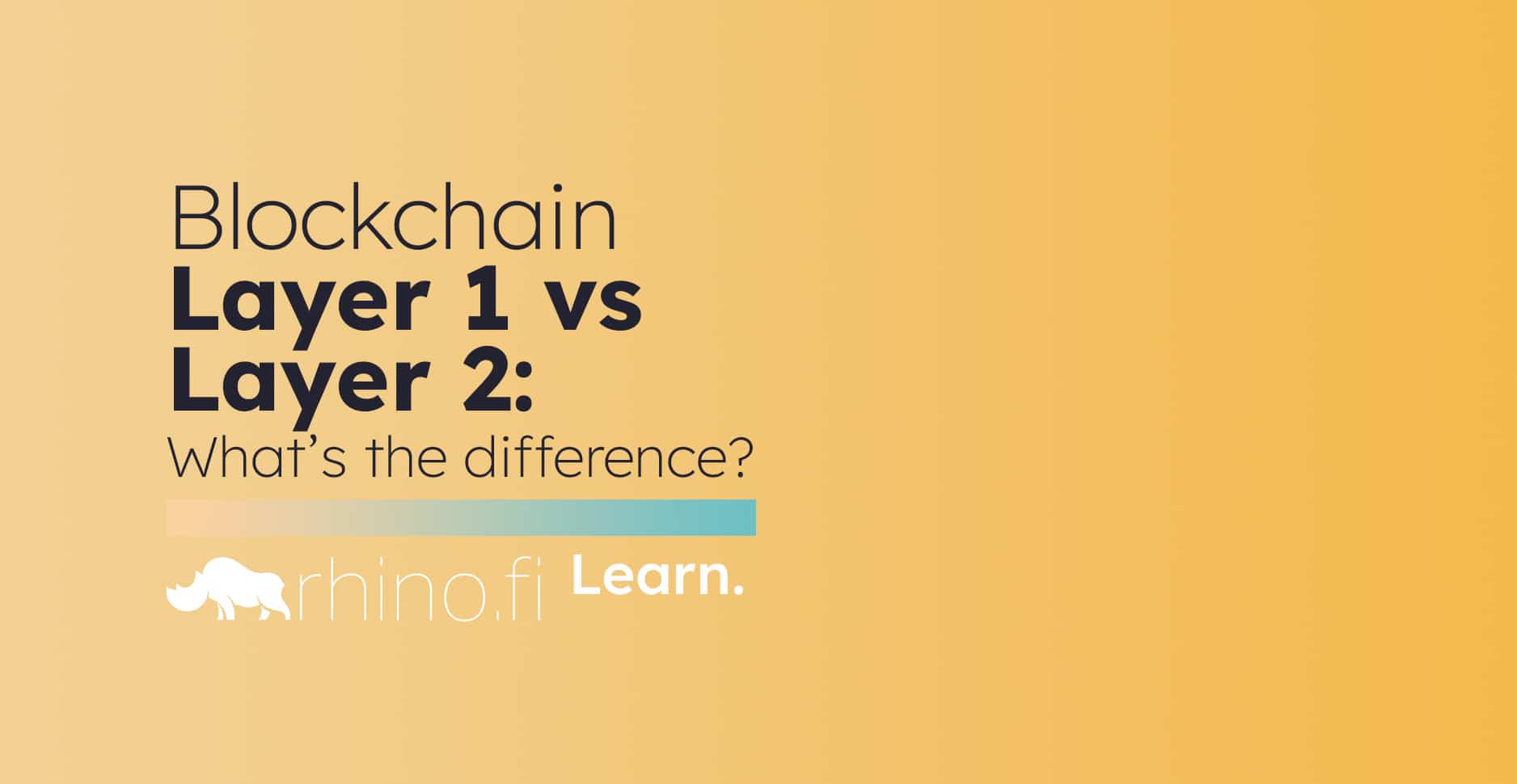The terms ‘layer 1’ and ‘layer 2’ refers to a blockchain with two distinct tiers.
- Layer 1 is the primary network which sets the rules for transactions and provides a central ledger, which is updated whenever any transaction takes place.
- Layer 2 is a network of third-party satellites. These platforms and applications are built on top of, and interact with, the main chain.
The terms are still an emerging concept in crypto. However they are rapidly gaining traction, particularly on the Ethereum blockchain.
A galaxy of different projects, including rhino.fi, are being built on layer 2. These new projects are designed to take some of the traffic off the main network, so it can scale.
In this edition of RhinoLearn we’ll explain the key differences between layer 1 and layer 2, and look at why layer 2 has emerged as a concept.
The origin of layer 2
To understand the origins of layer 2 we need to understand the evolution of blockchains themselves.
Blockchains began with only limited features. You could create (or mint) digital coins and tokens on them, and make transactions.
However this changed with the creation of programmable blockchains, led by Ethereum. These blockchains allow developers to build their own applications, such as forums and trading exchanges, on the chain itself.
This has hugely expanded the possibilities of blockchain technology, particularly in the realm of decentralised finance. On Ethereum, for example, you can now invest, access loans and earn yield opportunities using the apps built on the blockchain.
However, this has also created huge strain on the network. With thousands of people accessing hundreds of different services, computing space is now at a premium and this is driving up gas (or transaction) fees.
This is most evident on the Ethereum blockchain. Users are now facing long wait times to complete simple transactions and, crucially, they’re having to pay hefty gas fees for the privilege (see our explainer on gas fees for more info on this topic).
Layer 2 has emerged as a solution to this problem.
Projects built on layer 2 inherit the core security features of layer 1. Crucially, however, they have the power to take transactions and validate them independently.
Layer 2 projects don’t have the traffic issues of the main chain, so users can make trades, swaps and investments much more quickly – without the gas fees.
If you want an analogy, think of a motorway, or highway. Layer 1 is the motorway itself, and it’s prone to gridlock at busy times. Layer 2 projects are the slip roads that take traffic off the motorway and allow them to bypass the traffic, creating a smoother experience for everyone.
Ok, so now we’ve examined the function of layer 2, let’s drill down into the details of how it differs from layer 1.
Blockchain vs non-blockchain
Layer 1 networks, with a few exceptions, are always blockchains.
However, many layer 2 projects are decentralised applications — just like the apps you use on your phone or laptop, but without a single controlling company behind them.
There are many different types of layer 2 project, and you can read about them here (link to scalability solutions explainer).
Function
The layer 1 blockchain is a universal foundation. It maintains a record of all transactions, no matter which layer they take place on, to ensure the security of the entire network.
By contrast, the main function of layer 2 is to increase transaction speed and reduce gas fees. Because of this, projects on layer 2 can fulfil specific services, like providing a trading platform (in rhino.fi’s case). However, they always send a record of their work back to layer 1.
Speed
Layer 1 blockchains must verify and post each transaction on-chain individually (this is another reason for the slow speeds).
Layer 2 transactions, on the other hand, are free to process transactions ‘off-chain’ in bulk, using scalability engines like StarkWare (the one used by rhino.fi). Once they’ve handled a batch of transactions, they post a single record back to the main layer 1 chain, so it can update.
What’s more, layer 1 blockchains have to go through various different stages when processing transactions, to fulfil their security requirements. Many blockchains rely on proof of work, a method which is extremely secure but requires members of the network to validate the transactions themselves, which can be time-consuming.
However, layer 2 projects are free to use their own validation methods, which is another big plus for users.
Coins vs tokens
A layer 1 blockchain like Ethereum can mine its own coins. These are strictly instruments of monetary value, and they can be used to pay for goods and services (physical and digital).
Layer 2 projects cannot mine coins, but they can mint tokens. These tokens carry their own financial functions, but they can be used for a wide range of other purposes too. To explore this difference in more detail, check out our Coins vs Tokens explainer (LINK).
So, in summary:
- Layer 1 is the main blockchain – layer 2 are the projects that sit on top.
- Layer 1’s main function is to provide security and record transactions: Layer 2 has lots of different functions.
- Layer 2 projects can reduce the load on Layer 2 by processing transactions independently, using their own super-fast validation techniques.
Enjoyed this explainer? Check out our post on rollups (LINK), the specific type of layer 2 technology used by rhino.fi.





